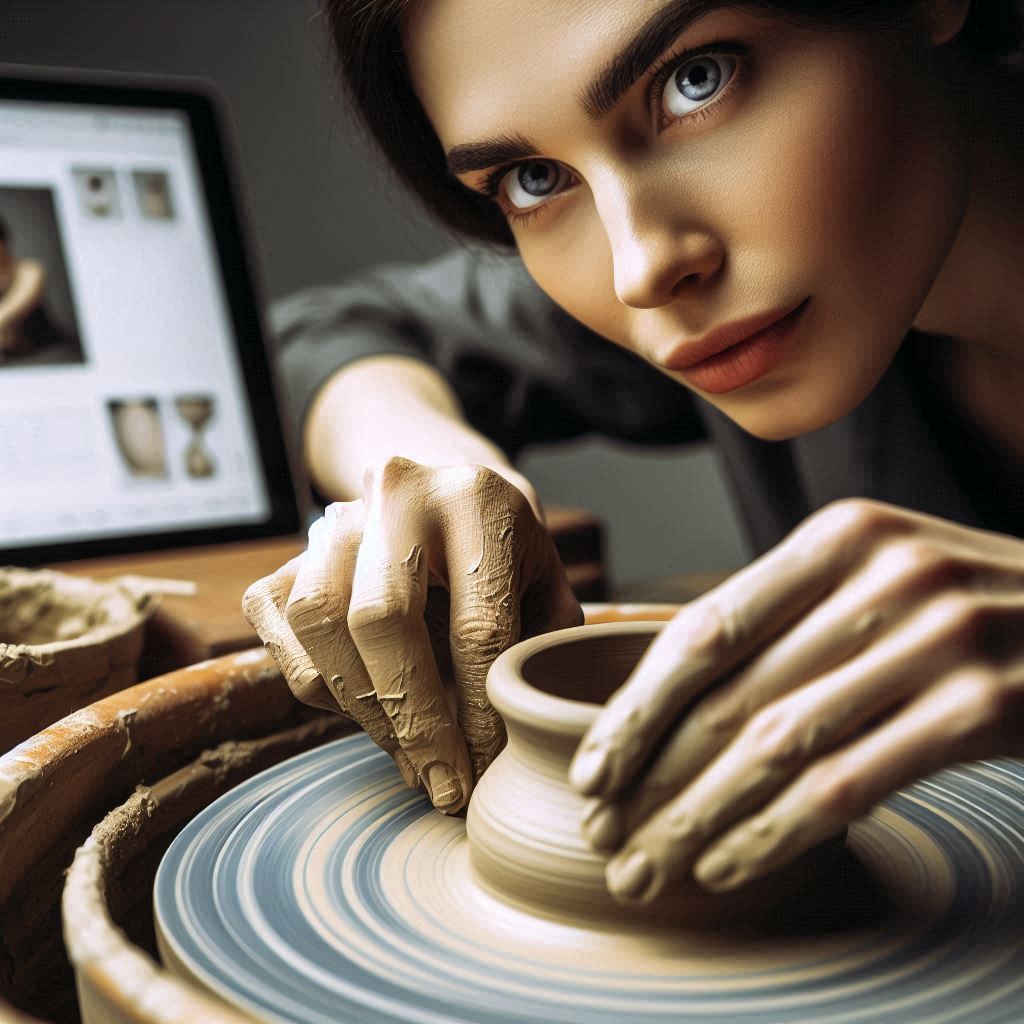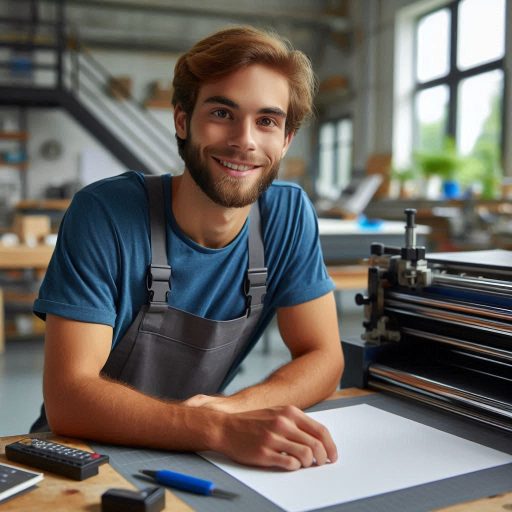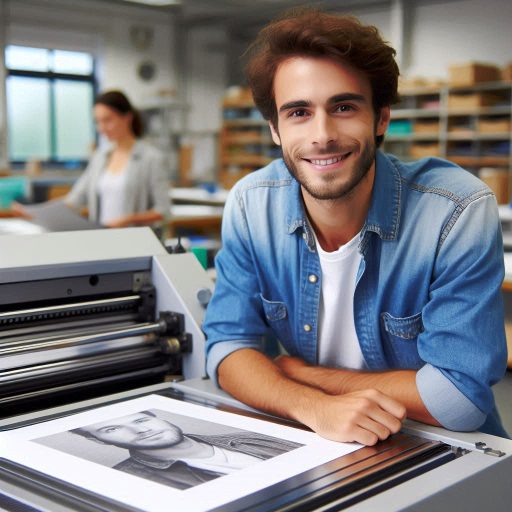Introduction
Ceramic art has a rich history, dating back thousands of years across many cultures.
Ancient civilizations used clay to create functional and decorative items, often incorporating unique artistic styles.
This art form, deeply rooted in tradition, has continued to evolve over time.
Today, ceramic art is still celebrated for its beauty and craftsmanship, but modern technology is playing a crucial role in transforming the field.
Technology is revolutionizing ceramic art by introducing new tools and techniques.
Artists now use 3D printers to shape intricate designs that were once difficult to create by hand.
Digital modeling software allows for precision and experimentation, enabling artists to explore more complex forms.
Even traditional pottery wheels have been enhanced with electronic features that give artists greater control over their work.
Moreover, advances in kiln technology have improved firing processes, leading to more consistent and efficient results.
Artists can now experiment with different firing temperatures and techniques, pushing the boundaries of their creative potential.
In modern times, the intersection of technology and ceramic art is fostering innovation.
Artists can blend time-honored practices with cutting-edge advancements, creating unique and contemporary pieces.
The integration of technology is not only expanding artistic possibilities but also making ceramic art more accessible to a wider audience.
As technology continues to advance, the future of ceramic art holds even greater potential for creativity and innovation.
Evolution of Ceramic Art Techniques
Traditional methods of creating ceramic art
Traditional methods of creating ceramic art have been passed down through generations, with artisans using their hands to shape clay into various forms.
Techniques such as hand-building, coiling, and slab construction have been foundational in the world of ceramics.
- Hand-building: This technique involves creating ceramic pieces by hand, using simple tools like the fingers or a paddle.
- Coiling: Coiling is a method where long ropes of clay are stacked on top of each other to build up the walls of a vessel.
- Slab construction: Slab construction involves rolling out large, flat sheets of clay that are then cut and assembled into a final piece.
How technology has influenced the evolution of techniques in ceramic art
However, with the advancement of technology, the world of ceramic art has witnessed a significant transformation.
The introduction of modern equipment, tools, and materials has revolutionized the way artists create their work.
One of the most impactful technologies in ceramic art is the electric pottery wheel.
This machine allows artists to quickly and efficiently throw clay on a rotating wheel, enabling them to create symmetrical pieces with precision.
Transform Your Career Today
Unlock a personalized career strategy that drives real results. Get tailored advice and a roadmap designed just for you.
Start NowAdditionally, the kiln, a critical component in ceramics, has also seen advancements.
With the introduction of digital kilns, artists now have more control over the firing process, resulting in consistent and predictable outcomes.
Benefits of technology in ceramic art
- Increased efficiency: Technology has sped up the process of creating ceramic art, allowing artists to produce more work in less time.
- Enhanced precision: Modern tools and equipment enable artists to achieve precise shapes and designs that were previously difficult to attain.
- Expanded possibilities: Technology has opened up new possibilities in ceramic art, pushing the boundaries of what can be created with clay.
Overall, while traditional methods of creating ceramic art will always hold a special place in the hearts of artists, the integration of technology has undoubtedly enriched the field and continues to inspire new innovations in ceramic art.
Read: Ceramic Art for Beginners: Getting Started
Digital Tools and Software for Ceramic Artists
Various digital tools available for ceramic artists
As technology continues to advance, ceramic artists have access to a wide range of digital tools and software that can enhance their creative process and increase efficiency in ceramic art production.
Here, we explore some of the most popular digital tools available for ceramic artists:
- 3D modeling software: Programs like Rhino, Blender, and AutoCAD allow artists to create intricate designs and prototypes digitally before moving on to actual ceramic production.
- CNC machines: Computer Numerical Control machines can be used to cut, shape, and carve ceramic materials with precision, saving time and ensuring accuracy in the production process.
- Laser cutters: These machines can be used to create detailed patterns, textures, and designs on ceramic surfaces, adding a unique touch to the finished pieces.
- Virtual reality (VR) tools: Artists can immerse themselves in a virtual environment to visualize and experiment with different designs, shapes, and forms before bringing them to life in the studio.
- 3D printers: These devices can produce ceramic prototypes and models quickly and cost-effectively, allowing artists to test out ideas and make adjustments before final production.
How these tools enhance the creative process and efficiency in ceramic art production
By incorporating digital tools and software into their practice, ceramic artists can benefit in numerous ways:
- Increased precision: Digital tools allow artists to create intricate designs with a level of precision that would be difficult to achieve by hand.
- Time-saving: Automation and digital processes speed up production times, allowing artists to focus more on the creative aspects of their work.
- Cost-effective: Using digital tools can reduce material waste and minimize the need for rework, saving artists money in the long run.
- Exploration of new techniques: Digital tools enable artists to explore new techniques and experiment with different forms and textures that may not be possible with traditional methods.
- Collaboration: Artists can collaborate with engineers, designers, and other professionals to combine their expertise and create innovative ceramic artworks using digital tools.
Digital tools and software enhance ceramic art production efficiency.
They allow artists to push creative boundaries with ease.
These technologies open new possibilities for unique designs.
Artists use them to explore and create compelling pieces.
Read: Printmaking Techniques: Screen Printing Basics
3D Printing in Ceramic Art
3D printing has revolutionized the field of ceramic art by providing artists with innovative tools and techniques to create intricate and unique pieces.
Here is an in-depth look at the role of 3D printing in ceramic art, along with its benefits and challenges:
Role of 3D printing in ceramic art
- Allows artists to experiment with complex geometries that are difficult to achieve using traditional methods.
- Enables artists to create customized pieces with precision and accuracy.
- Opens up new possibilities for design and artistic expression.
- Streamlines the production process and reduces the time and labor required to create ceramic pieces.
- Provides a platform for collaboration between artists, designers, and technicians to bring ideas to life.
Benefits of using 3D printing technology in creating ceramic pieces
- Increased efficiency in creating intricate and detailed ceramic pieces.
- Reduction in material wastage as 3D printing only uses the required amount of ceramic material.
- Ability to scale production easily and modify designs without additional tooling costs.
- Enhanced creativity and innovation by pushing the boundaries of traditional ceramic art techniques.
- Opportunity to reach new audiences by offering unique and personalized ceramic artworks.
Challenges of using 3D printing technology in creating ceramic pieces
- High initial investment in acquiring and maintaining 3D printing equipment.
- Limited availability of ceramic materials suitable for use in 3D printers.
- Complexity in mastering the software and technical skills required for 3D printing in ceramics.
- Concerns about the durability and sustainability of 3D printed ceramic pieces.
- Potential issues with achieving the desired finish and texture in 3D printed ceramic artworks.
In essence, 3D printing technology has significantly impacted the world of ceramic art by empowering artists with new possibilities and pushing the boundaries of creativity.
Though challenging, 3D printing offers many benefits to ceramic art.
It transforms how artists explore and innovate their craft.
The advantages far exceed any potential drawbacks.
This tool opens exciting new possibilities for creative expression.
Read: Finding Inspiration for Your Ceramic Art

Augmented Reality in Ceramic Art
Augmented reality is revolutionizing the way we perceive and interact with art, including ceramic art.
Let’s delve into how this technology is being used in ceramic art exhibitions and its potential to enhance the viewer’s experience.
Use of Augmented Reality in Ceramic Art Exhibitions
Artists and curators are incorporating augmented reality to bring a digital layer to physical ceramic pieces.
By scanning a ceramic artwork with a mobile device, viewers can unlock additional information or virtual elements.
This technology allows for a deeper understanding of the artist’s process, inspiration, and context behind the work.
Augmented reality can also provide interactive features that engage the audience in a more immersive way.
Some exhibitions use AR to create virtual galleries where viewers can explore artworks from different angles.
The Potential of Augmented Reality in Enhancing Viewer Experience with Ceramic Art
Augmented reality offers a novel way to bridge the gap between traditional and digital art forms.
Viewers can access additional layers of information about the artwork, enriching their understanding and appreciation.
AR enhances the educational value of ceramic art exhibitions by providing detailed insights into the creative process.
Interactivity through augmented reality fosters a more engaging and personalized experience for viewers of all ages.
By leveraging AR technology, ceramic artists can reach a wider audience and spark interest in their creations.
Overall, augmented reality presents exciting opportunities for the ceramic art world, enabling new forms of expression, interaction, and engagement.
Advancing technology brings innovative AR uses in ceramic art exhibitions.
These enhancements elevate viewers’ experiences and appreciation of timeless artworks.
Read: Printmaking for Interior Design and Decor
Online Platforms for Ceramic Artists
Importance of Online Platforms for Ceramic Artists
Online platforms have revolutionized the way ceramic artists showcase and sell their work.
These platforms provide a global reach, allowing artists to connect with a broader audience than ever before.
By having an online presence, ceramic artists can attract new customers, build a fan base, and ultimately grow their brand.
Technology’s Role in Enabling Ceramic Artists to Reach a Wider Audience
Technology has played a crucial role in empowering ceramic artists to reach a wider audience.
With the rise of social media and online marketplaces, artists can now easily share their work with people from all around the world.
Platforms like Instagram, Etsy, and Pinterest have become popular tools for artists to showcase their creations and attract potential buyers.
Through these platforms, artists can create visually appealing profiles, share photos and videos of their work, engage with followers, and even sell their pieces directly to customers.
The direct-to-consumer model has reshaped ceramic sales.
It removes intermediaries, letting artists manage their own sales directly.
This shift empowers creators to control the entire process.
Establishing an Online Presence for Ceramic Artists
Establishing an online presence is essential for ceramic artists looking to grow their brand and expand their reach.
Create a professional website to showcase your portfolio.
Share your artistic process and attract potential buyers.
Set up a profile on popular platforms for more visibility.
Connect with fellow artists and expand your network easily.
An online presence helps ceramic artists join online exhibitions.
It enables participation in virtual art fairs and projects.
This boosts their visibility and networking opportunities greatly.
Technology has made it easier than ever for artists to promote their work and engage with a global community of art enthusiasts.
In fact, online platforms have become indispensable tools for ceramic artists to promote, sell, and connect with their audience.
Technology has transformed the way artists share their work, enabling them to reach a broader audience and establish a strong online presence.
By leveraging these platforms effectively, ceramic artists can enhance their visibility, grow their brand, and ultimately succeed in the competitive world of contemporary art.
Sustainability and Technology in Ceramic Art
As the world shifts toward more sustainable practices, the ceramic art field is not left behind.
Technology plays a significant role in promoting eco-friendly methods within the discipline, allowing artists to maintain creative freedom while reducing their environmental impact.
This section delves into how technology is fostering sustainability in ceramic art and highlights eco-friendly techniques and materials adopted by artists.
How Technology Promotes Sustainability in Ceramic Art Practices
Advancements in technology have allowed ceramic artists to create more sustainably, with innovative tools and methods contributing to both energy efficiency and waste reduction.
Here are key ways technology is transforming sustainability in ceramic art:
Energy-Efficient Kilns
- Traditional kilns consume large amounts of energy, but modern, energy-efficient kilns are now available, utilizing better insulation and temperature control systems.
- Electric kilns with smart sensors adjust the heat levels during the firing process, minimizing energy wastage while still producing high-quality ceramics.
3D Printing for Ceramics
- 3D printing allows for precision in creating ceramic objects, reducing material waste by using only what‘s necessary.
- With the development of clay-based filaments, 3D printing technology can build intricate ceramic forms layer by layer, drastically minimizing excess material.
Water Recycling Systems
- In many ceramic studios, water is used for shaping and cleaning clay, leading to significant waste.
Modern water filtration and recycling systems are now used to reduce water consumption. - These systems purify and reuse water during various ceramic processes, helping artists minimize their environmental footprint.
Digital Design and Prototyping
- Digital modeling tools allow ceramic artists to experiment with designs without the need for physical prototypes, reducing material waste.
- Programs such as Rhino and CAD help artists visualize the final product before production, ensuring more sustainable use of resources.
Sustainable Glazing Technologies
- The development of new glaze formulations using technology is making it possible to create non-toxic, lead-free glazes that are less harmful to both the artist and the environment.
Eco-Friendly Techniques and Materials Adopted by Ceramic Artists
Alongside technological advancements, many ceramic artists are adopting sustainable practices through the use of eco-friendly techniques and materials.
These strategies allow them to stay true to the craft while minimizing environmental harm.
Recycling Clay
- Instead of discarding excess clay, many artists now reclaim and recycle it, reducing the need to mine new materials.
- Clay reclaiming machines simplify the process by mixing, kneading, and preparing unused clay for reuse, preventing wastage.
Non-Toxic Materials
- The use of non-toxic, earth-friendly clays and pigments has become more prevalent, helping to reduce harmful chemicals in production processes.
- Some artists also create their own natural glazes using locally sourced minerals and organic materials.
Alternative Firing Methods
- Artists are experimenting with alternative firing techniques that require less energy, such as solar kilns or low-temperature firing methods.
- Raku firing is another sustainable method, as it requires minimal energy and uses organic materials for fuel, such as wood or sawdust.
Eco-Conscious Packaging
- Ceramic artists are also embracing eco-conscious packaging by using recyclable and biodegradable materials when shipping their products, reducing the overall carbon footprint of their work.
Locally Sourced Materials
- Many ceramic artists are turning to locally sourced clays and materials, which reduces the carbon emissions associated with transportation.
- Using regional materials also encourages artists to be more conscious of their local environment and its resources.
Small Batch Production
- Small-batch, made-to-order production has gained popularity among ceramic artists, as it ensures that only necessary items are created, reducing overproduction and waste.
In short, the fusion of technology and sustainability is reshaping ceramic art practices.
With energy-efficient tools, digital design platforms, and eco-friendly materials, ceramic artists are finding ways to minimize their environmental impact while maintaining creative integrity.
As the field continues to evolve, the role of technology will undoubtedly remain crucial in promoting sustainability.
Delve into the Subject: Landscape Architecture: Job Outlook and Salaries
Collaboration between Ceramic Artists and Technologists
The growing trend of collaboration between ceramic artists and technologists
The growing trend of collaboration between ceramic artists and technologists is becoming increasingly popular in the art world.
Ceramic artists combine creativity with technologists’ technical expertise.
Together, they produce innovative and cutting-edge ceramic art.
This collaboration merges artistry with technology for groundbreaking results.
Their joint effort pushes the boundaries of ceramic design.
Benefits of interdisciplinary collaboration
- Exploration of new techniques: By working together, ceramic artists and technologists can explore and experiment with new techniques that would not be possible on their own.
- Integration of technology: Technologists can help ceramic artists integrate technology into their works, adding a new dimension to traditional ceramic art.
- Pushing boundaries: Collaboration between artists and technologists pushes the boundaries of ceramic art, allowing for the creation of unique and groundbreaking pieces.
- Multidisciplinary perspectives: With different backgrounds and expertise, collaboration brings diverse perspectives to the creative process, leading to richer and more dynamic artworks.
- Enhanced problem-solving: Artists and technologists can work together to solve challenges and find innovative solutions that may not have been possible working alone.
Ceramic artists and technologists collaborate to unlock new possibilities.
They explore innovative techniques and push creative boundaries together.
By merging technology with traditional art, they expand possibilities.
This partnership leads to groundbreaking advancements in ceramic artistry.
This interdisciplinary approach opens up new possibilities for creative expression and innovation in ceramic art.
Conclusion
As discussed in this blog post, technology plays a crucial role in shaping the landscape of ceramic art.
From digital design tools to 3D printing technology, artists have a multitude of innovative resources at their disposal.
These advancements have not only revolutionized the way ceramics are created but have also opened up new possibilities for artists to experiment and push boundaries in their work.
It is essential for ceramic artists to embrace these technological advancements and integrate them into their practice to stay relevant in a constantly evolving art world.
By doing so, artists can broaden their creative horizons, expand their technical skills, and redefine traditional notions of ceramic art.
Furthermore, the significance of technology in the future of ceramic art cannot be understated.
As new technologies continue to emerge, they will undoubtedly continue to reshape the field and provide artists with exciting opportunities for growth and exploration.
Embracing innovation and staying curious about technological advancements will be key in driving the evolution of ceramic art and ensuring its longevity in the art world.




